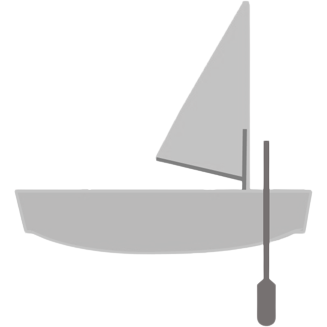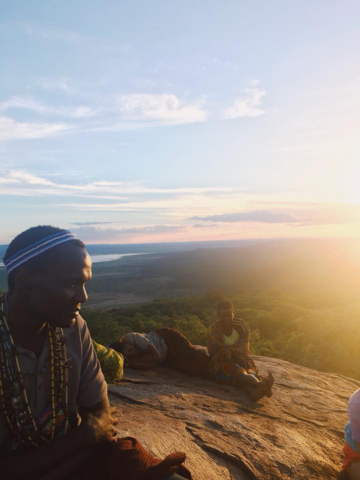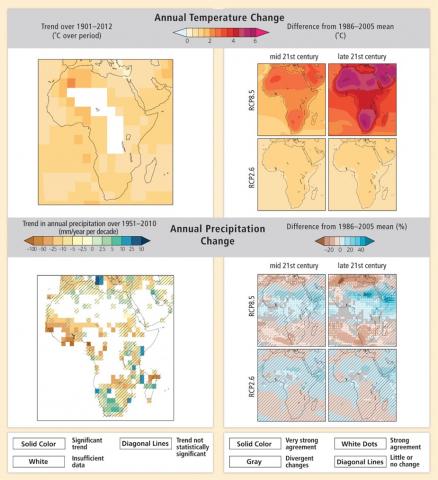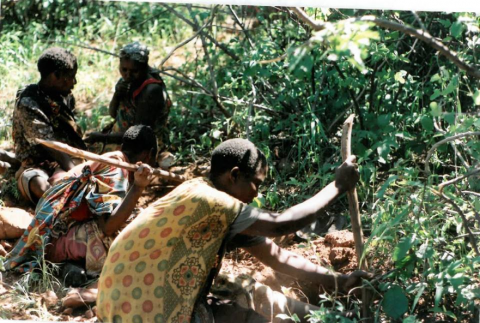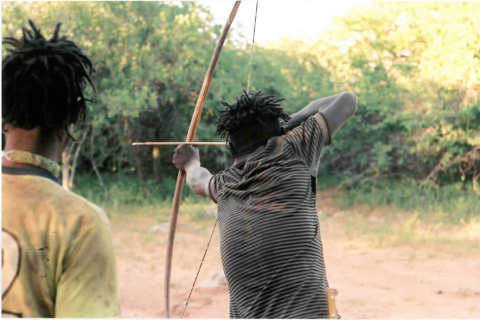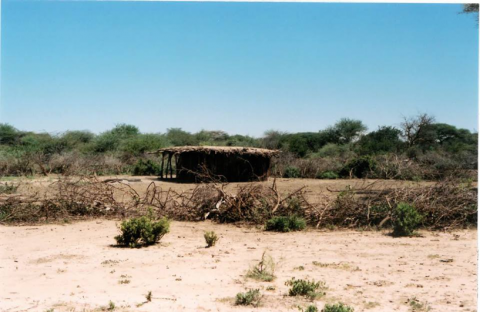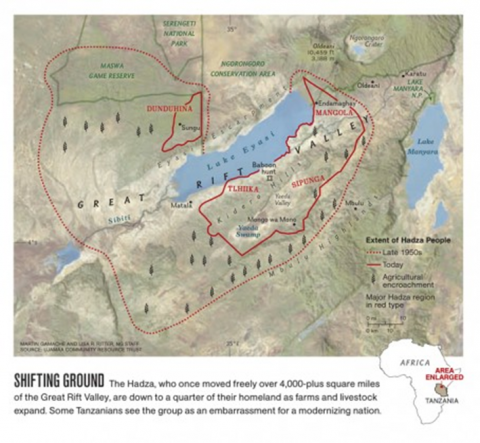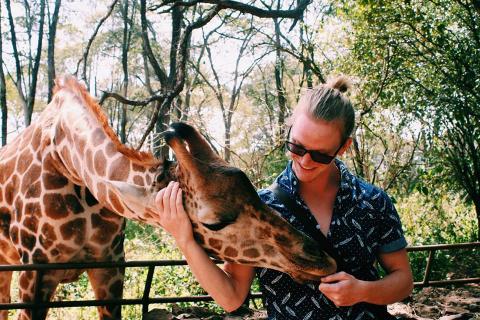Introduction
Climate change is one of the leading environmental and humanitarian issues of this century. It influences nearly every aspect of human civilization; politics, environmental movements, economics, and even tourism. Its impacts are seen in countless ways with everything from heatwaves and droughts to blizzards and hurricanes, local and international scales. Perhaps those that are the most vulnerable are those that have contributed to climate change the least, as well as have the least ability to prevent any further damages (Mabulla, 2012). The Hadzabe of Tanzania are one such people.
The Paris Agreement was developed in 2015 and is planned to go into effect in 2020, with the international goal of limiting global warming below 2˚C and hopes of limiting warming to below 1.5˚C (UNFCCC, 2016). According to the IPCC Special Report, 2018, their Five Reasons for Concern; unique and threatened ecosystems (including indigenous peoples), extreme weather events, uneven distribution of impacts, global aggregate impacts, and large scale singular events, are all of moderate-high risk or greater. Even under a plan which limits global warming to 1.5˚C all of these reasons for concern are of lesser, but still significant, risk (IPCC, 2018).
The Hadzabe
The Hadzabe are a community of 1,000-1,500 people living in the Western Rift Block in Tanzania (Eyasi Basin) (Madson, 2000). Archeologists believe that the Hadzabe have been living in relative seclusion in this region for, potentially, tens of thousands of years (Mabulla, 2007). The Hadzabe are one of the few remaining cultures that still maintain a semi-nomadic hunter-gatherer lifestyle (Dorobo Safaris, 2018). This lifestyle has afforded the Hadzabe with being one of the only known peoples to have never experienced famine as their food and water sources have become drought resistant over thousands of years of evolution, but even these resources have their limitations (Dorobo Safaris, 2018).
Climate Change Hazards
Various studies and reports have already found significant increases in temperature since the 1980s for many parts of East Africa as well as an increase in extreme warm weather events for the states that border the West Indian Ocean since the 1960s (IPCC, 2014). Additionally, precipitation has decreased in the Great Horn of Africa due to the change in sea level pressure between the southern Mediterranean Sea and the southern tropical Indian Ocean (IPCC, 2014). On the more extreme side of both of these problems, show that over the last 30-60 years weather events like severe drought and heavy rains have become more common in East Africa (IPCC, 2014). It is important to keep in mind that when heavy rain events occur it is often at the beginnings of the rainy seasons and the soils are too dry to absorb the water, leading to extreme flooding and more damages than benefits (Hadzabe Interviews, 2018).
Exposure of the Hadzabe
Tanzania, specifically, is expected to experience greater climate change impacts than some of its neighboring East African states. Temperature predictions are in the range of 2-4˚C increase with the more interior landscapes experiencing the higher temperatures by 2100 (Mabulla, 2012). Other studies used in Mabulla’s 2012 research also indicated a continued decrease in precipitation up to 20% with the rains becoming even more infrequent, less predictable, and more volatile. Additionally, extreme events such as drought and El Nino are expected to increase in frequency and severity, prolonging the dry seasons in Tanzania due to the changes in temperature and precipitation (Mabulla, 2012).
Vulnerability of the Hadzabe
Historically the Hadzabe have had a well-varied diet due to the numerous habitats of the Eyasi Basin (Mabulla, 2012). However, over the recent decades' climate change has altered the flora of the region and in turn the fauna, which leaves them with a far more limited variety and quantity to sustain themselves (Dorobo Safaris, 2018). A series of interviews with the Hadzabe (Mabulla, 2012) found that 85% of them could feel that the years had grown warmer and 74% stated that water resources had become scarce, with the last heavy rain event being the 1997-1998 El Niño event. These changes in climate have caused several of the perennial rivers, streams, and small lakes to become seasonal or, in some cases, extinct. Another 79% of the interviewees indicated that these climate changes had impacted their hunting strategies and 73% reported it impacting foraging strategies.
It is not only the direct impacts of climate change that the Hadzabe have been struggling against. Pastoralist peoples like the Maasai, Barabaig, Datoga, and several others have been encroaching on Hadzaland and increasingly so in recent years. These peoples are also feeling the effects of climate change and must move their herds to lands with plenty of grasses to survive, but this has becoming increasingly difficult with the changing climate and modern land ownership laws (Hutchinson, 2016); (Gibbons, 2018). The herds eat the grasses down to the ground and clean the leaves off the young trees, inhibiting the wild species from feeding. The herders themselves also have tremendous impacts on the landscape by clear-cutting the land in order to build their corrals and homes (Madsen, 2000).
The farming communities that have been encroaching on Hadzaland have similar impacts on the environment. They will oftentimes clear-cut or burn all natural vegetation in order to make way for their fields. The tilling of the land makes the already light soils even more prone to erosion. In many cases the farmers will also be required to drill boreholes in order to irrigate their fields. Of course this irrigation causes further decrease in the water resources as well as increases in soil erosion and soil salinity, making it more difficult or impossible for the natural vegetation to return (Dorobo Safaris, 2018).
Adaptation Efforts
Non-profit organizations have been a great help to the people in protecting and reclaiming their lands. Three of the organizations that have been of the most benefit to the Hadzabe people are CUSO the Canadian University Student Organization, Dorobo Safaris, and UCRT the Ujamaa Community Resource Team (Madsen, 2000); (Dorobo Safaris, 2018). Dorobo Safaris has been providing money to the Hadzabe through safari tours and grants from the Dorobo Fund. Much of this money, along with help from CUSO and UCRT, has been put towards acquiring legal ownership of their native lands. The Ujamaa Community Resource Team also helps to empower marginalized communities such as the Hadzabe by advocating for their land rights to local and national governments (Dorobo Safaris, 2018).
About the Author
Austin Schessl graduated from St. Lawrence University in 2019 with a bachelor of science in Environmental Studies-Biology. He began researching the impacts of climate change on the Hadzabe for Dr. Jon Rosales' course "Adapting to Climate Change" the spring following his experience with the SLU Kenya Semester Program. There he saw first hand the struggles that were being faced by the Hadza people and the importance of climate change in our present live.
Sources
Dorobo Safaris (2018, February). Personal Communication.
Gibbons, A. (2018, May 18). Hadza on the Brink. Retrieved from
http://science.sciencemag.org/content/360/6390/700
Hadzabe (2018, February). Personal Communication.
Hutchinson, E. (2016, July 14). Tanzania's Maasai Facing Impacts of Climate Change.
Retrieved from https://www.climatecentral.org/news/tanzanias-maasai-facing-impacts-
IPCC. (2014). Climate Change 2014: Impacts, Adaptation, and Vulnerability. Retrieved
from https://archive.ipcc.ch/report/ar5/wg2/
IPCC. (2018). Global Warming of 1.5˚C.
Madsen, A. (2000). The Hadzabe of Tanzania Land and Human Rights for a Hunter-
gatherer Community. Copenhagen: International Secretariat of IWGIA.
Mabulla, A. Z. (2007). Hunting and Foraging in the Eyasi Basin, Northern Tanzania: Past,
Present and Future Prospects. African Archaeological Review, 24(1-2), 15-33.
doi:10.1007/s10437-007-9013-x
Mabulla, I. A. (2012, September). Impacts of Climate Change and Other Factors on Hadza
Hunter-foragers of Northern Tanzania. University of Dar es Salaam.
UNFCCC, (2016). The Paris Agreement
Image Sources
Brooke, Lindsey (Photographer). (2018). Giraffe Center, Nairobi, Kenya.
Crossan,Sarah (Photographer). (2018). Tanzanian Sunset with the Hadzabe.
Lake Forest College (2019). Environmental Studies, Hadza. Retrieved from https://www.lakeforest.edu/academics/programs/environmental/courses/es368/vlaar.php
IPCC (2014). Part B: Regional Aspects, Africa. Retrieved from https://archive.ipcc.ch/report/graphics/index.php? t=Assessment%20Reports&r=AR5%20-%20WG2&f=Chapter%2022
Schessl, Austin (Photographer). (2018). Hadzabe Hunter Overlooking Hadzaland.
Schessl, Austin (Photographer). (2018). Pastoralist's Hut and Corral.
Sollitt, Emma (Photographer). (2018). Hadza Men Practicing Archery.
Sollitt, Emma (Photographer). (2018). Hadza Women Foraging for Tubers.
